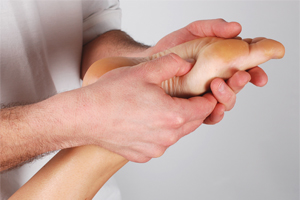 Chronic foot pain is absolutely no fun at all, and can destroy your enjoyment of life. One of the most common causes of foot pain – one that affects nearly two million people yearly in the U.S. – is plantar fasciitis, which is an inflammation of the plantar fascia ligament that connects the heel bone (calcaneous) and the toes. This ligament is composed of thick strong fibrous bands of tissue, and runs along the entire bottom of the foot. It stretches and contracts with every step or movement, and may become inflamed when tiny tears occur in the tissue.
Chronic foot pain is absolutely no fun at all, and can destroy your enjoyment of life. One of the most common causes of foot pain – one that affects nearly two million people yearly in the U.S. – is plantar fasciitis, which is an inflammation of the plantar fascia ligament that connects the heel bone (calcaneous) and the toes. This ligament is composed of thick strong fibrous bands of tissue, and runs along the entire bottom of the foot. It stretches and contracts with every step or movement, and may become inflamed when tiny tears occur in the tissue.
The most common symptom of planar fasciitis is a burning or aching pain on the bottom of the foot, often near the heel, where this ligament attaches to the heel bone. It is often experienced in the mornings and the pain is usually the most intense, because the ligament has had time to rest and relax during the evening, but then tightens up and becomes painful again when we put pressure on it by standing or walking. The pain tends to decrease with activity, but may recur after periods of walking or standing. Half of people diagnosed with plantar fasciitis say that their pain is constant; 90% say that it hurts when they press on the area around the heel.
There are many potential causes of plantar fasciitis. Overuse during exercise or physical activity is one of the most common, and athletes who run, jump, or perform other repetitive movements that put pressure on the feet are prone to this condition. Standing for long periods of time on concrete or very hard surfaces may be very provocative and elicit ongoing symptoms. We were not designed to stand on such highly dense man-made materials for long periods of time. Albeit, it is the norm in our society. It may also be caused or aggravated by arthritis and diabetes, especially in the elderly. Interestingly enough, one of the most common causes of plantar fasciitis is wearing the wrong shoes. Shoes with little or no arch support or that provide insufficient support or cushioning can put strain on the tendons and, over time, cause plantar fasciitis. Improper footwear is even more likely to be a cause if you have flat feet, high arches, overpronation, or underpronation. Being overweight also places additional strain on your feet that can lead to this condition.
Whatever the cause, plantar fasciitis can take all the fun out of walking or even moving around easily. More important, it is a condition that should be diagnosed and, if present, treated early, before it becomes more serious. Traditional medical treatment of plantar fasciitis tends to focus on reducing the pain (via anti-inflammatory medications such as Ibuprofen or more serious pain relievers) and alleviating pressure on the heel. Unfortunately, this regimen does not address the potential causes of the disorder. For many, chiropractic manipulation of the feet and related joints (in addition to traditional approaches such as the use of ice packs and avoiding for a time the movements that seem to exacerbate the pain) may help to restore a proper range of motion, and thus remove the cause of the problem.
In addition, chiropractors – especially those who specialize in sports medicine – may be able to analyze patients' gait (how they walk or run) and thus prescribe better footwear (or orthotics to wear inside their current shoes) that will help both to relieve pain and prevent future occurrences of it. In my office I use various modalities depending on the onset of the condition and the motivation of the patient to resolve the symptoms. In many cases a conservative measure is to correct the insufficiencies of the foot with custom orthotics but only after treating the condition with a device known as an EPAT or Extracorporeal Pulse Activation Treatment. This is the most advanced and highly effective non-invasive treatment method cleared by the FDA. This proprietary technology is base on a unique set of pressure waves that stimulate the metabolism, enhance blood circulation and accelerate the healing process. Damaged tissue gradually regenerates and eventually heals. This non-invasive office based procedure represents a breakthrough treatment option for a broad range of musculoskeletal conditions. There are many exercises and lifestyle changes that can be performed at home that can also help, such as stretching and self-massage performed in the evenings and mornings. How quickly these therapies may provide relief depends of course on each individual case, but relief can be found. For further information and to schedule a consultation with Dr. Rivano please call (973)845-6282. Our office is located in Florham Park, NJ right on Columbia Turnpike. Or, simply fill out the contact information on this link http://rivanochiropractic.com/appointment.php.